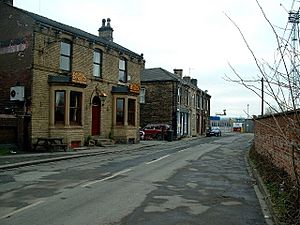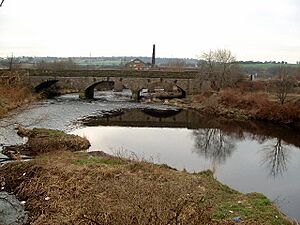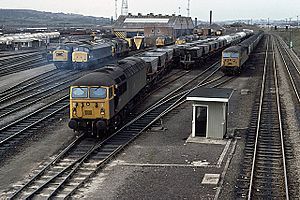Healey, Ossett facts for kids
Healey is a small village and industrial area in West Yorkshire, England. It sits on the east side of the River Calder, just outside Ossett, near Wakefield. Healey grew a lot during the Industrial Revolution when factories for making cloth and fulling (a process to clean and thicken wool fabric) were built here.
An old, unused railway yard called Healey Mills Marshalling Yard is located east of the village. It's south of Ossett and west of Horbury, along the old Manchester and Leeds Railway line.
History
People have lived and worked around Healey for a very long time. We've found signs of human activity from the Bronze Age (a time when people used bronze tools) and farming from the Roman period. During the Middle Ages, people quarried stone here, but didn't farm much. Later, in the post-medieval period, there was farming again, with fields showing a pattern called "ridge and furrow."
The River Calder could be crossed by a shallow part (a ford) west of Healey during Roman times. Later, a ferry helped people cross the river near Healey New Mill.
The Calder and Hebble Navigation was a canal system built in the late 1700s. It connected to the River Calder nearby with a lock (a special gate system to raise or lower boats). The first mill, Healey Mill, was set up by 1791. Then came Healey Low Mill by 1817, and Healey New Mill by 1827.
The Railway's Impact
The Manchester and Leeds Railway line was built through Healey by 1840. To make way for the railway, a new, straighter path was dug for the River Calder. This new path cut off the road to one of the mills, which caused some problems for the mill owners. Even so, the railway company was allowed to continue their work.
A large five-arch bridge was built to carry the railway over this new river path. Because of the delays, a temporary wooden bridge was used when the railway first opened. In 1851, the railway owners planned to move the river into the new path permanently, but this never happened. Instead, a three-span bridge replaced the wooden one.
By 1854, there were three different mills and a pub called "The Millers Arms Inn" in the area. The new river path that was dug for the railway was never fully connected to the main river. The northern part was partly filled in and used to build a dye factory (which later became Calder Vale Mill). The southern part was used as a pond for the mill.
In 1855, the Ossett Gas works was built on Healey Road. A Sewage Works was added south of it in the 1870s. The first houses in Healey and on Healey Road were built in the late Victorian era.
In the 1960s, the railway sidings (extra tracks for parking trains) east of Healey were turned into a modern railway shunting yard. This brought big changes. The River Calder was moved south to make more room for the new yard. The old mill pond was filled in. Healey Low Mill was pulled down, and the old sewage works were removed. Three new railway bridges were also built over the Calder.
Healey Mills Rail Yard
By 1920, many railway sidings had grown along the railway line east of Healey, known as Healey Mill Sidings. In the 1960s, these sidings were updated to handle train wagons more efficiently.
Building the new yard involved digging a new river channel over 900 meters long for the River Calder, moving it south. The site was leveled with a huge amount of earth. A road bridge near Horbury Bridge was rebuilt and made longer. Three new railway bridges were built over the River Calder, and gas and electricity lines had to be moved.
How the Yard Worked
The new yard was designed as a "hump shunting" yard. This means trains would be pushed over a small hill (a hump), and gravity would then make the wagons roll down onto different tracks. This allowed them to sort up to 4,000 wagons a day! The tracks where trains arrived were west of the River Calder. The main yard was built on the larger area of the old sidings. The main control tower was south of the main railway line. The yard opened in 1963 and cost about £3.5 million. A special place for diesel trains to be kept and repaired opened at Healey Mills in 1967.
The marshalling yard closed in 1987. After that, the site was used to store trains and locomotives (engines). After British Rail became private companies, the site was used by a company called EWS.
After 2010, the site was mainly used for train crews to change shifts. The depot for drivers at Healey Mills closed in 2012. It moved to temporary offices at Wakefield Kirkgate railway station.
Healey Today
Healey New Mill is still standing and is now used for different businesses. The mill building and its chimney are special buildings that are protected because of their history. The old pub from 1872, The Millers Arms, is now called The Brewer's Pride.
Network Rail still owns the Power Signal Box, which used to control trains from Horbury to Huddersfield. However, it is no longer used.
In 2011, the only public bus service in Healey was the number 102 bus. It was run by Arriva Yorkshire and connected Healey to Wakefield through Ossett.




